PA Fireball Meteorite Possibly Found
by Mike Hankey, under Mason Dixon Meteor
A friend tipped me off about this article that was published in The Aegis Hartford County MD newspaper. Thanks Kristan! Man I hope this is the real deal.
UPDATE – FAIL
I sent this story out to the meteorite community. Within 15 minutes of pressing send on my email, I got about 20 replies that said there is no way this is a meteorite. Here is the best analysis I’ve seen so far from Eric at MeteoriteBlog.com. Thank Eric that is a pretty comprehensive analysis.
6 Comments for this entry
2 Trackbacks / Pingbacks for this entry
-
PA Fireball Meteorite NOT Found! Meteorwrong | Meteorite Blog
July 31st, 2009 on 12:27 pm[…] Mike’s Post here: PA Fireball Meteorite Possibly Found AKPC_IDS += "802,";Popularity: unranked [?] Share and […]
-
Argus Rocks » Meteorwrongs in the News
August 21st, 2009 on 12:11 am[…] July 29th, 2009: Suspected Meteorite in Whiteford, PA, USA […]
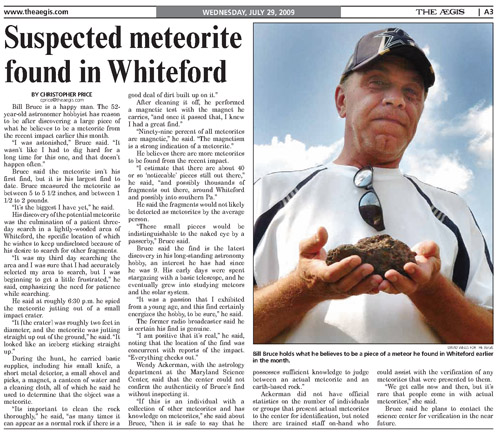
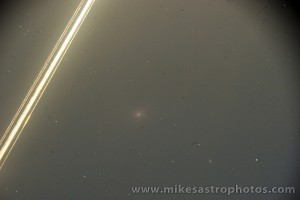
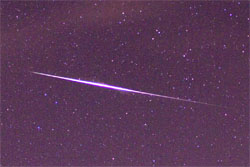
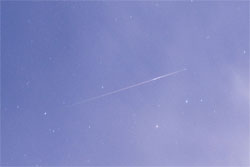
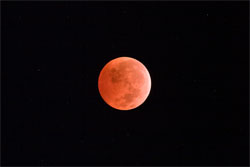


July 31st, 2009 on 12:26 pm
Dear Mike:
Thank you for making this story available. A few comments: Just because a suspected rock sticks to a magnet does not automatically make it a meteorite. Many common earth rocks will stick to a magnet, so the magnet test is just a first step. Also, a freshly fallen meteorite will usually exhibit a rich black fusion crust (think of a charcoal briquette) as a result of burning in our atmosphere.
Summary: The rock shown in the above photo does not look like a meteorite, and certainly not a freshly fallen one. I would expect the subject of the newspaper story (who claims to have found meteorites before) to know these basic points.
To learn about meteorite identification please follow this link:
http://www.aerolite.org/found-a-meteorite.htm
If your readers would like to see what real meteorites look like, please visit our sale page:
http://www.aerolite.org/meteorites-for-sale.htm
Cheers,
Geoff of Meteorite Men
July 31st, 2009 on 12:39 pm
I was only a few miles from here on the way up to Safe Harbor on Saturday! It will be interesting to see how it plays out. After reading Geoff’s comment and the Meteorite Blog article, I’m not convinced.
July 31st, 2009 on 2:29 pm
yep, i don’t believe anything in the media, newspapers, tv, books, paid programming, …
if it is really important, check out the details for your self. too bad this is the information often used to select our leaders.
don
July 31st, 2009 on 3:18 pm
I’m going to make a wild guess that this thing fell off of the USS Starship Slag.
August 10th, 2009 on 9:40 am
I’m still highly convinced that your telescope image is not that of a meteor and most likely that of aircraft lights. Every meteor, whether it’s a fireball or not will produce an ionized column that glows…even momentarily. The brighter the meteor, the brighter the ionized column. Of course not all of these ionized columns (trails and trains) will be visible to the naked eye, but they are there. If you had observed this fireball with a standard pair of 7X50 binoculars, the column would probably reach out and grab you with no problem. Surely bright enough to leave some kind of trace after glow in the photograph. Even just a smidgen of this afterglow, butI see no hint of this. These afterglow trains initially line up with the meteors path, but due to high winds in these regions, They distort very quickly(within a second or two) and essentially jump off the meteors path. If the meteor was photographed thru a telescope adequately, there should be some hint of these distorted surrounding trains…even just a little bit…but I do not see this. Your image also looks very much like those of aircraft trails. Good luck in the future though…George Zay, Sonora, CA
August 10th, 2009 on 11:56 am
George,
Thanks for the feedback. A lot of people have had similiar issues interpretting my picture. Part of the problem is there is no picture like this in existance, so there is nothing to compare it to. Most photographic evidence of meteors are not long exposures. They are video cameras or short exposures. They are also not telescopic. Leaving the camera lens open for 3 minutes causes all of the light that passes through the image to be recorded. If a big piece of light crosses the same path as a smaller piece of light you won’t be able to see the original small piece of light. In addition the brightest light will over power / overwrite any lighter shades or colors. It is more difficult to interpret long exposures than short exposures.
The picture has already been through the vetting process and the most respected sources in the field have already verified its authenticity, including and not limited to:
– discoverer of tc3 and leading asteroid hunting astronomer (the only
man to have ever detected an asteroid in space and predict its impact
with earth, and then have it actually happen)
– sky and telescope magazine
– nasa employees
If you haven’t already please read this email chain that addresses all of the issues you bring up here:
http://www.mikesastrophotos.com/baltimore-pa-meteor/mason-dixon-medeorite-photo-confirmed-by-leading-asteroid-hunter/
Further supporting the claim, the picture exists in perfect harmony with all other photographic evidence and eye witness reports in regard to the trajectory. There are no contradictions with the when and where. I was there, I heard the sonic boom, my house shook, I went outside and look at the camera and the picture was there. The timing
was exact.
In addition, if you examine the high-res version of the picture you can clearly see pieces of the meteor falling away (there are over 9). The photo captured the moment of retardation and you can actually see little meteorites burning out and starting to arc away from the main stream. Sorry but a plane trail would not arc, especially not when the rest of the plane stayed in a straight line.
Regarding the airplane trails, I have photographed over 100 airplanes and trails and they are generally about 1 pixel wide in the photographs. For a plane to have made this image it would have been flying at 200 feet in the same exact location as the meteor at the same exact time. Statistically this is more impossible than actually photographing a fireball through a telescope.
I appreciate your comments. If you would like to examine the high-res raw version of the picture I would be happy to share it with you.
Thanks,
Mike